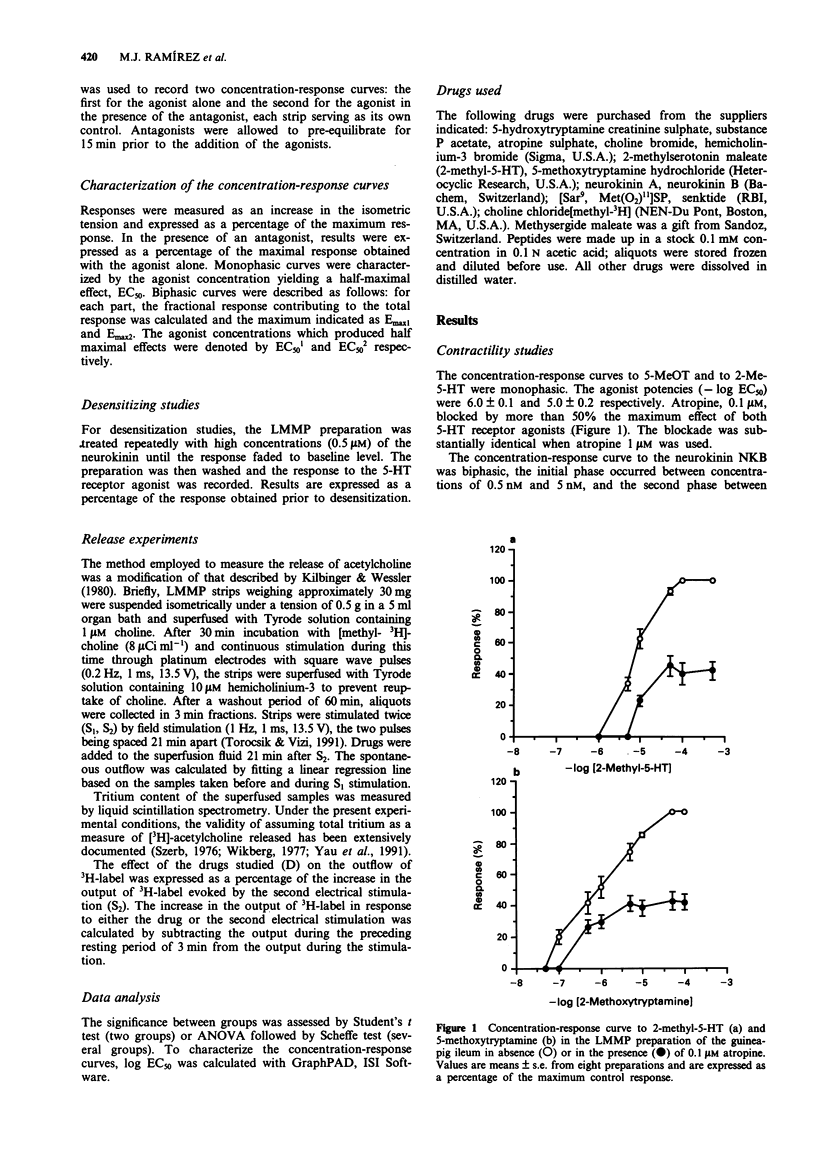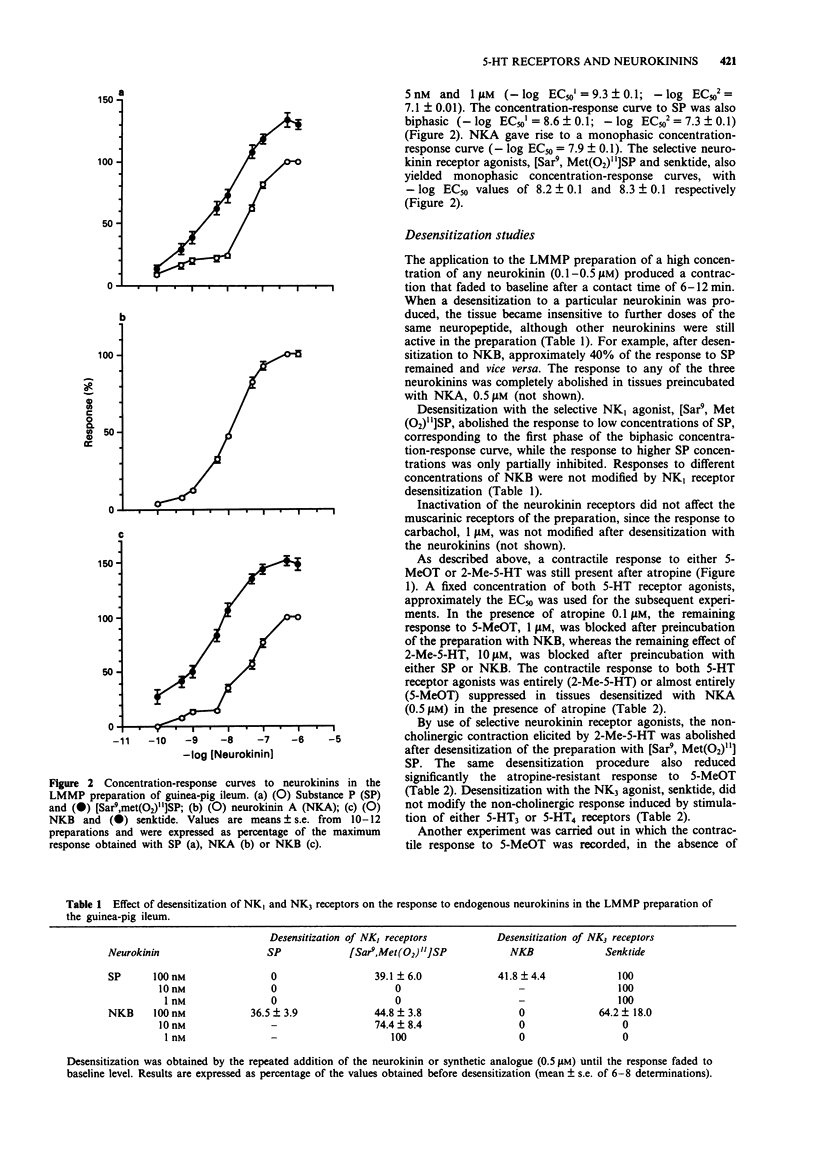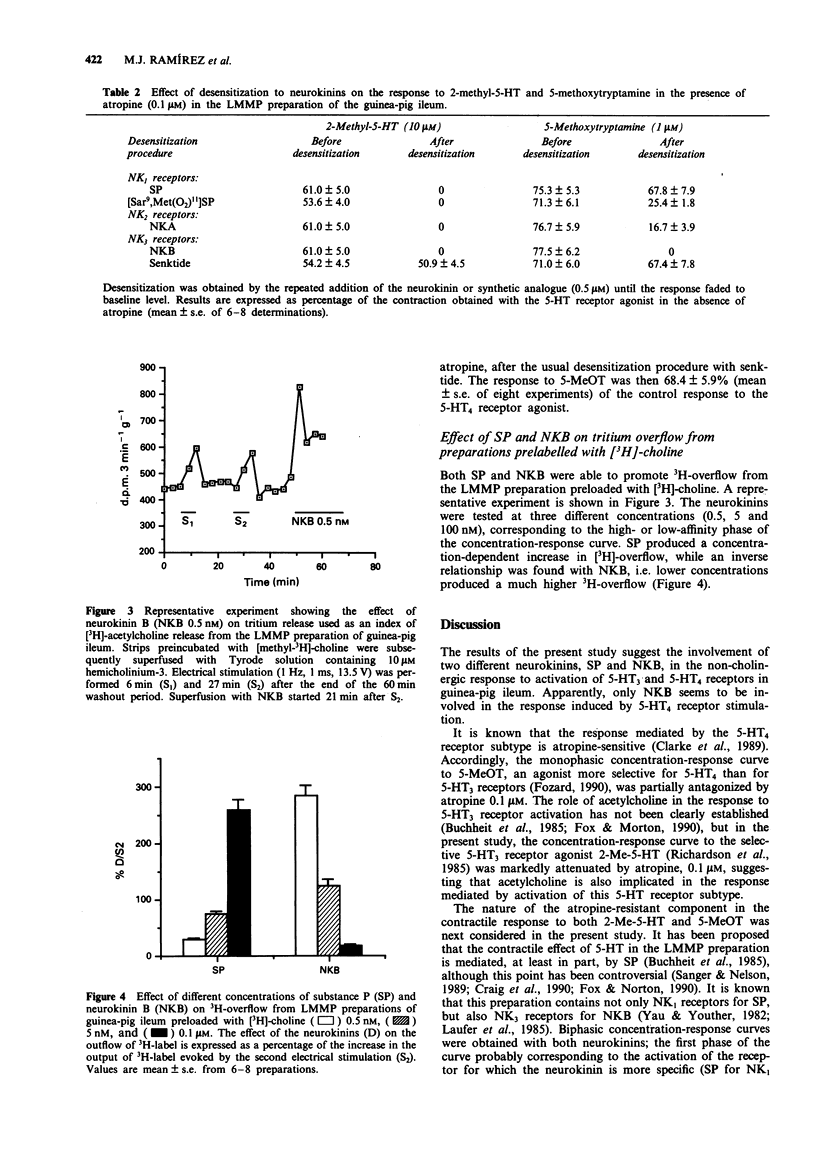Abstract
1. The involvement of neurokinins in the non-cholinergically-mediated contractile response induced by stimulation of 5-HT3 and 5-HT4 receptors has been examined in the longitudinal muscle-myenteric plexus preparation of the guinea-pig ileum. 2. The 5-HT3 receptor agonist, 2-methyl-5-hydroxytryptamine (2-methyl-5-HT), showed a lower potency in this preparation than the more selective 5-HT4 receptor agonist 5-methoxytryptamine. The effect of both drugs was markedly reduced by atropine. 3. Substance P (SP) and neurokinin B (NKB) produced biphasic concentration-response curves in the preparation. Neurokinin A (NKA), the NK1 receptor agonist, [Sar9,Met(O2)11]SP and the NK3 receptor agonist, senktide yielded monophasic concentration-response curves. 4. After desensitization of the NK1 receptor with SP or [Sar9,met(O2)11]SP, in the presence of atropine, the contractile response to 2-methyl-5-HT was entirely blocked. Desensitization of NK3 receptors with NKB, also in the presence of atropine, fully suppressed the 5-HT4 receptor-mediated contraction evoked by 5-methoxytryptamine. 5. In preparations prelabelled with [3H]-choline, SP produced a concentration-dependent increase in tritium overflow, an index of [3H]-acetylcholine release, while an inverse relationship was found with NKB. At low neurokinin concentrations, the releasing effect of NKB was much more marked. 6. It is suggested that in the response to 5-HT3 receptor stimulation, there is a role for SP and acetylcholine. NKB appears to be preferentially involved in the release of acetylcholine elicited by stimulation of 5-HT4 receptors.
Full text
PDF





Selected References
These references are in PubMed. This may not be the complete list of references from this article.
- Akasu T., Ohta Y., Koketsu K. Neuropeptides facilitate the desensitization of nicotinic acetylcholine-receptor in frog skeletal muscle endplate. Brain Res. 1984 Jan 9;290(2):342–347. doi: 10.1016/0006-8993(84)90953-3. [DOI] [PubMed] [Google Scholar]
- Arenas E., Alberch J., Perez-Navarro E., Solsona C., Marsal J. Neurokinin receptors differentially mediate endogenous acetylcholine release evoked by tachykinins in the neostriatum. J Neurosci. 1991 Aug;11(8):2332–2338. doi: 10.1523/JNEUROSCI.11-08-02332.1991. [DOI] [PMC free article] [PubMed] [Google Scholar]
- Bradley P. B., Engel G., Feniuk W., Fozard J. R., Humphrey P. P., Middlemiss D. N., Mylecharane E. J., Richardson B. P., Saxena P. R. Proposals for the classification and nomenclature of functional receptors for 5-hydroxytryptamine. Neuropharmacology. 1986 Jun;25(6):563–576. doi: 10.1016/0028-3908(86)90207-8. [DOI] [PubMed] [Google Scholar]
- Buchheit K. H., Engel G., Mutschler E., Richardson B. Study of the contractile effect of 5-hydroxytryptamine (5-HT) in the isolated longitudinal muscle strip from guinea-pig ileum. Evidence for two distinct release mechanisms. Naunyn Schmiedebergs Arch Pharmacol. 1985 Mar;329(1):36–41. doi: 10.1007/BF00695189. [DOI] [PubMed] [Google Scholar]
- Butler A., Hill J. M., Ireland S. J., Jordan C. C., Tyers M. B. Pharmacological properties of GR38032F, a novel antagonist at 5-HT3 receptors. Br J Pharmacol. 1988 Jun;94(2):397–412. doi: 10.1111/j.1476-5381.1988.tb11542.x. [DOI] [PMC free article] [PubMed] [Google Scholar]
- Clapham D. E., Neher E. Substance P reduces acetylcholine-induced currents in isolated bovine chromaffin cells. J Physiol. 1984 Feb;347:255–277. doi: 10.1113/jphysiol.1984.sp015065. [DOI] [PMC free article] [PubMed] [Google Scholar]
- Clarke D. E., Craig D. A., Fozard J. R. The 5-HT4 receptor: naughty, but nice. Trends Pharmacol Sci. 1989 Oct;10(10):385–386. doi: 10.1016/0165-6147(89)90177-6. [DOI] [PubMed] [Google Scholar]
- Craig D. A., Clarke D. E. Pharmacological characterization of a neuronal receptor for 5-hydroxytryptamine in guinea pig ileum with properties similar to the 5-hydroxytryptamine receptor. J Pharmacol Exp Ther. 1990 Mar;252(3):1378–1386. [PubMed] [Google Scholar]
- Craig D. A., Eglen R. M., Walsh L. K., Perkins L. A., Whiting R. L., Clarke D. E. 5-Methoxytryptamine and 2-methyl-5-hydroxytryptamine-induced desensitization as a discriminative tool for the 5-HT3 and putative 5-HT4 receptors in guinea pig ileum. Naunyn Schmiedebergs Arch Pharmacol. 1990 Jul;342(1):9–16. doi: 10.1007/BF00178965. [DOI] [PubMed] [Google Scholar]
- Dion S., D'Orléans-Juste P., Drapeau G., Rhaleb N. E., Rouissi N., Tousignant C., Regoli D. Characterization of neurokinin receptors in various isolated organs by the use of selective agonists. Life Sci. 1987 Nov 16;41(20):2269–2278. doi: 10.1016/0024-3205(87)90538-8. [DOI] [PubMed] [Google Scholar]
- Drapeau G., D'Orléans-Juste P., Dion S., Rhaleb N. E., Rouissi N. E., Regoli D. Selective agonists for substance P and neurokinin receptors. Neuropeptides. 1987 Jul;10(1):43–54. doi: 10.1016/0143-4179(87)90088-6. [DOI] [PubMed] [Google Scholar]
- Fox A., Morton I. K. An examination of the 5-HT3 receptor mediating contraction and evoked [3H]-acetylcholine release in the guinea-pig ileum. Br J Pharmacol. 1990 Nov;101(3):553–558. doi: 10.1111/j.1476-5381.1990.tb14119.x. [DOI] [PMC free article] [PubMed] [Google Scholar]
- Furness J. B., Bornstein J. C., Murphy R., Pompolo S. Roles of peptides in transmission in the enteric nervous system. Trends Neurosci. 1992 Feb;15(2):66–71. doi: 10.1016/0166-2236(92)90029-8. [DOI] [PubMed] [Google Scholar]
- GADDUM J. H., PICARELLI Z. P. Two kinds of tryptamine receptor. Br J Pharmacol Chemother. 1957 Sep;12(3):323–328. doi: 10.1111/j.1476-5381.1957.tb00142.x. [DOI] [PMC free article] [PubMed] [Google Scholar]
- Guard S., Watson S. P., Maggio J. E., Too H. P., Watling K. J. Pharmacological analysis of [3H]-senktide binding to NK3 tachykinin receptors in guinea-pig ileum longitudinal muscle-myenteric plexus and cerebral cortex membranes. Br J Pharmacol. 1990 Apr;99(4):767–773. doi: 10.1111/j.1476-5381.1990.tb13004.x. [DOI] [PMC free article] [PubMed] [Google Scholar]
- Jacoby H. I., Lopez I., Wright D., Vaught J. L. Differentiation of multiple neurokinin receptors in the guinea pig ileum. Life Sci. 1986 Nov 24;39(21):1995–2003. doi: 10.1016/0024-3205(86)90323-1. [DOI] [PubMed] [Google Scholar]
- Kilbinger H., Stauss P., Erlhof I., Holzer P. Antagonist discrimination between subtypes of tachykinin receptors in the guinea-pig ileum. Naunyn Schmiedebergs Arch Pharmacol. 1986 Oct;334(2):181–187. doi: 10.1007/BF00505819. [DOI] [PubMed] [Google Scholar]
- Kilbinger H., Wessler I. Inhibition by acetylcholine of the stimulation-evoked release of [3H]acetylcholine from the guinea-pig myenteric plexus. Neuroscience. 1980;5(7):1331–1340. doi: 10.1016/0306-4522(80)90205-5. [DOI] [PubMed] [Google Scholar]
- Laufer R., Gilon C., Chorev M., Selinger Z. Desensitization with a selective agonist discriminates between multiple tachykinin receptors. J Pharmacol Exp Ther. 1988 May;245(2):639–643. [PubMed] [Google Scholar]
- Laufer R., Wormser U., Friedman Z. Y., Gilon C., Chorev M., Selinger Z. Neurokinin B is a preferred agonist for a neuronal substance P receptor and its action is antagonized by enkephalin. Proc Natl Acad Sci U S A. 1985 Nov;82(21):7444–7448. doi: 10.1073/pnas.82.21.7444. [DOI] [PMC free article] [PubMed] [Google Scholar]
- Lee C. M., Iversen L. L., Hanley M. R., Sandberg B. E. The possible existence of multiple receptors for substance P. Naunyn Schmiedebergs Arch Pharmacol. 1982 Mar;318(4):281–287. doi: 10.1007/BF00501166. [DOI] [PubMed] [Google Scholar]
- Linnik M. D., Butler B. T., Gaddis R. R., Ahmed N. K. Analysis of serotonergic mechanisms underlying benzamide-induced gastroprokinesis. J Pharmacol Exp Ther. 1991 Nov;259(2):501–507. [PubMed] [Google Scholar]
- Meulemans A. L., Schuurkes J. A. Is the action of cisapride on the guinea-pig ileum mediated via 5-HT4 receptors? Eur J Pharmacol. 1992 Feb 25;212(1):51–59. doi: 10.1016/0014-2999(92)90071-b. [DOI] [PubMed] [Google Scholar]
- Molinero M. T., Del Rio J. Substance P, nicotinic acetylcholine receptors and antinociception in the rat. Neuropharmacology. 1987 Dec;26(12):1715–1720. doi: 10.1016/0028-3908(87)90122-5. [DOI] [PubMed] [Google Scholar]
- Paton W. D., Vizi E. S. The inhibitory action of noradrenaline and adrenaline on acetylcholine output by guinea-pig ileum longitudinal muscle strip. Br J Pharmacol. 1969 Jan;35(1):10–28. doi: 10.1111/j.1476-5381.1969.tb07964.x. [DOI] [PMC free article] [PubMed] [Google Scholar]
- Richardson B. P., Engel G., Donatsch P., Stadler P. A. Identification of serotonin M-receptor subtypes and their specific blockade by a new class of drugs. Nature. 1985 Jul 11;316(6024):126–131. doi: 10.1038/316126a0. [DOI] [PubMed] [Google Scholar]
- Role L. W., Leeman S. E., Perlman R. L. Somatostatin and substance P inhibit catecholamine secretion from isolated cells of guinea-pig adrenal medulla. Neuroscience. 1981;6(9):1813–1821. doi: 10.1016/0306-4522(81)90215-3. [DOI] [PubMed] [Google Scholar]
- Sanger G. J., Nelson D. R. Selective and functional 5-hydroxytryptamine3 receptor antagonism by BRL 43694 (granisetron). Eur J Pharmacol. 1989 Jan 10;159(2):113–124. doi: 10.1016/0014-2999(89)90695-x. [DOI] [PubMed] [Google Scholar]
- Szerb J. C. Storage and release of labelled acetylcholine in the myenteric plexus of the guinea-pig ileum. Can J Physiol Pharmacol. 1976 Feb;54(1):12–22. doi: 10.1139/y76-003. [DOI] [PubMed] [Google Scholar]
- Töröcsik A., Vizi E. S. Presynaptic effects of methoctramine on release of acetylcholine. Neuropharmacology. 1991 Mar;30(3):293–298. doi: 10.1016/0028-3908(91)90157-7. [DOI] [PubMed] [Google Scholar]
- Watling K. J., Krause J. E. The rising sun shines on substance P and related peptides. Trends Pharmacol Sci. 1993 Mar;14(3):81–84. doi: 10.1016/0165-6147(93)90067-t. [DOI] [PubMed] [Google Scholar]
- Wikberg J. Release of 3H-acetylcholine from isolated guinea pig ileum. A radiochemical method for studying the release on the cholinergic neurotransmitter in the intestine. Acta Physiol Scand. 1977 Nov;101(3):302–317. doi: 10.1111/j.1748-1716.1977.tb06012.x. [DOI] [PubMed] [Google Scholar]
- Wormser U., Laufer R., Hart Y., Chorev M., Gilon C., Selinger Z. Highly selective agonists for substance P receptor subtypes. EMBO J. 1986 Nov;5(11):2805–2808. doi: 10.1002/j.1460-2075.1986.tb04571.x. [DOI] [PMC free article] [PubMed] [Google Scholar]
- Yau W. M., Bowen D. J., Youther M. L. Evidence for an involvement of eicosanoids in neurokinin3-receptor mediated acetylcholine release from myenteric neurons. Neurosci Lett. 1991 Aug 19;129(2):259–261. doi: 10.1016/0304-3940(91)90475-9. [DOI] [PubMed] [Google Scholar]
- Yau W. M., Youther M. L. Direct evidence for a release of acetylcholine from the myenteric plexus of guinea pig small intestine by substance P. Eur J Pharmacol. 1982 Jul 30;81(4):665–668. doi: 10.1016/0014-2999(82)90357-0. [DOI] [PubMed] [Google Scholar]


